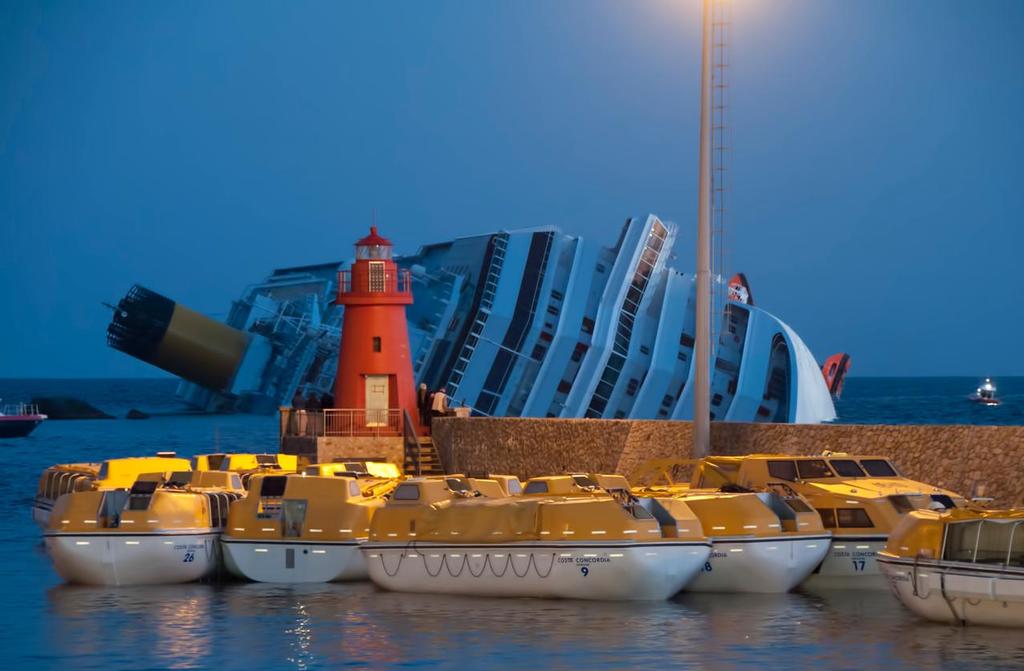Raising the Costa Concordia - the $1bn operation
by Media Services on 17 Sep 2013

Awaiting salvage SW
She's twice the size of the Titanic - 100,000 tonnes, three football fields in length - and has perched precariously on rocks on her side since foundering off the Tuscan coast on the night of January 13, 2012, in a tragedy that claimed 32 lives.
The unprecedented salvage operation of the Costa Concordia began after a maritime exclusion zone was established around the site.
There, engineers using remote controls have been guiding a synchronized leverage system of pulleys, counterweights and huge chains looped under the Concordia's carcass to delicately nudge the ship free from its rocky seabed perch just outside Giglio Island's harbour.
The goal is to raise it from its side by 65 degrees to vertical, as a ship would normally be, for eventual towing.
The operation, known as parbuckling, is a proven method to raise capsized vessels.
After seven hours of hoisting, supervisors said the ship had lifted by an angle of around 10 degrees towards the vertical axis.
Once it has risen by 24 degrees, the ship will begin righting itself thanks to gravity and to the giant tanks welded onto one side which will fill with water.
The start of the salvage was delayed by several hours because of storms on the island.
Activists had warned thousands of tons of toxic waste will pour into the sea, but officials said they were ready with clean-up boats if there were a spill.
Franco Gabrielli, head of the civil protection agency which is overseeing the operation, said the major concern for the salvage workers is the resistance of the hull of the ship to the enormous pressures it will have to withstand as it is winched up.
Giving orders from a control room on the shore is Nick Sloane, a South African salvage master with years of experience on shipwrecks around the world.
'We have done parbuckling before but never on a location like this,' Sloane said. 'She is on the side of a mountain on the seabed, balanced on two reefs and she is a really large ship - she's 100,000 tonnes plus... So it's never been done on this scale,' he said.
But he said ahead of the operation's start that all the risks had been identified.
Once the ship is lifted upright, it will have to stay in place until spring 2014, after autumn and winter storms have abated. The ship will then be hauled away and cut up for scrap in a shipyard.
Dubbed 'Captain Coward' for apparently abandoning the ship while passengers were still being evacuated, Captain Francesco Schettino is currently on trial, facing charges of manslaughter and abandoning ship. The trial started in July in Grosseto in Tuscany, the closest city to the scene of the disaster.
Schettino claims that the rocky reef the ship hit was not marked on his nautical charts - despite the fact that it appears on tourist maps of Giglio.
At the hearing, his lawyer denied that the captain had deliberately abandoned ship, instead insisting that the skipper had been inadvertently thrown off the ship!
Four crew members and the head of ship owner Costa Crociere's crisis unit were handed short prison sentences earlier this year for their roles in the crash.
The Costa Concordia had 4,229 passengers and crew from 70 countries on board when the crash happened and many people were sitting down for dinner on the first night of their cruise.
The salvage operation has cost US$855 million and could cost more than US$1 billion by its completion.
If you want to link to this article then please use this URL: www.sail-world.com/114574